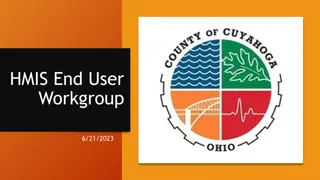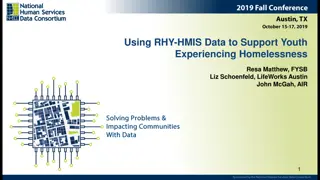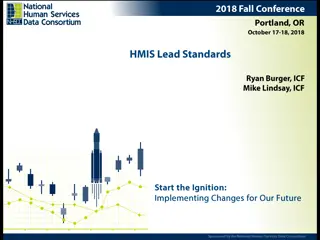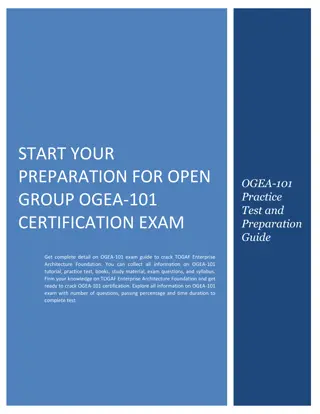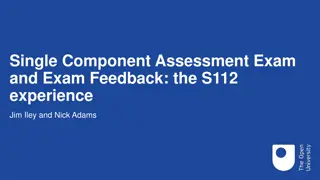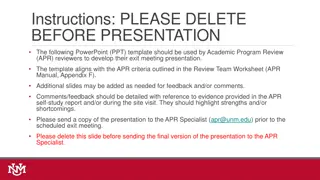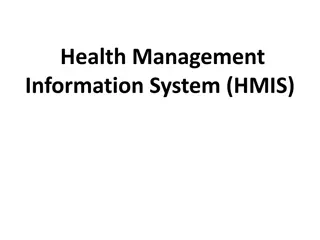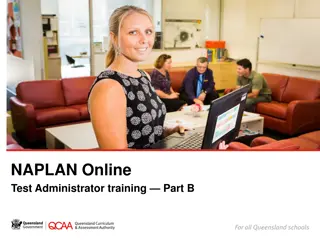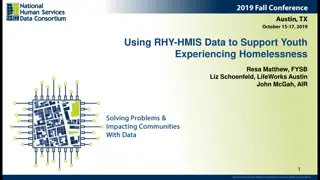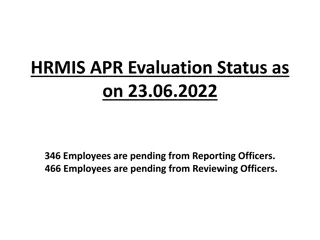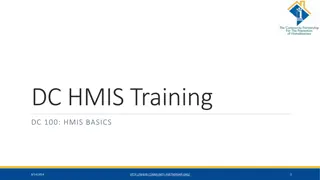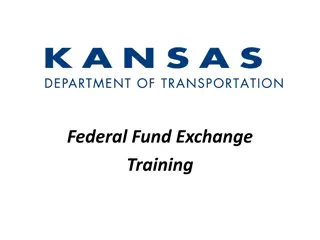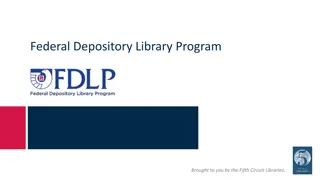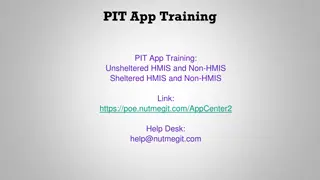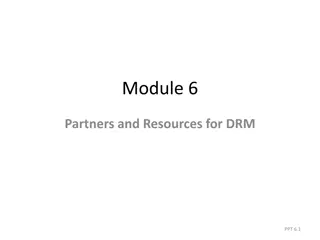HMIS 101 Module 2: Federal Partners APR System Administrator Training
This training series aims to equip HMIS System Administrators, end users, CoC representatives, consumers, and federal, state, and local partners with essential knowledge on HMIS participation, AHAR, and SHP-HMIS APR. Covering topics such as webinar format, submitting questions, webinar materials, and evaluation, this session offers a comprehensive overview of the HMIS ecosystem and its importance in supporting individuals experiencing homelessness. Join experts from various organizations to enhance your understanding of HMIS and contribute towards effective data management and program implementation.
Download Presentation

Please find below an Image/Link to download the presentation.
The content on the website is provided AS IS for your information and personal use only. It may not be sold, licensed, or shared on other websites without obtaining consent from the author.If you encounter any issues during the download, it is possible that the publisher has removed the file from their server.
You are allowed to download the files provided on this website for personal or commercial use, subject to the condition that they are used lawfully. All files are the property of their respective owners.
The content on the website is provided AS IS for your information and personal use only. It may not be sold, licensed, or shared on other websites without obtaining consent from the author.
E N D
Presentation Transcript
HMIS 101: MODULE 2 Federal Partners AHAR 101 SHP-HMIS Annual Performance Report (APR) HMIS SYSTEM ADMINISTRATOR TRAINING SERIES U.S. Department of Housing and Urban Development
Partners 2 Kat Freeman, The Cloudburst Group Natalie Matthews, Abt Associates, Inc. Chris Pitcher, The Cloudburst Group Jeff Ward, Abt Associates, Inc.
Purpose 3 Provide HMIS System Administrators, end users, CoC representatives, consumers, and federal, state, and local partners with a basic understanding of: HMIS Participation from other Federal Partners AHAR 101 SHP-HMIS APR
Webinar Format 4 This training is part of a series of trainings that will provide staff with the basic information needed to operate or participate in an HMIS It is anticipated that this series of trainings will be offered quarterly This training is anticipated to last 90 minutes Presenters will walk through presentation material
Submitting Questions 5 Because of the high volume of participants, all participants will be muted throughout the presentation Questions can be asked during the webinar via the Questions pane of Go To Webinar All questions that we cannot reply to should be submitted via the Ask the Expert function on www.hmis.info
Webinar Materials & Evaluation 6 Quick follow up survey will be emailed out after the webinar The webinar will be recorded, and all materials will be posted to HMIS.info (www.HMIS.info)
Overview of Training Series 7 HMIS 101 Modules I and II: Module I: HMIS History, Overview of Data and Technical Standards, Data Quality Concepts, and CoC APR 101 Module II: Federal Partners, AHAR 101, and SHP-HMIS APR 101 HMIS 101 Modules III, IV and V: Module III: In-Depth Data Standards Module IV: In-Depth Security, Privacy, and Governance Module V: Data Quality Standard and Compliance Plans HMIS 201: HMIS Budgeting and Staffing PIT and HIC Best Practice Highlights/ Use of Technology
Federal Partners 8 HMIS Participation by other Federal Partners
Session Objectives 9 Provide an overview of the status 5 federal partner program s use of HMIS: Veterans Administration (VA) Supportive Service for Veteran Families (SSVF) Grant and Per Diem (GPD) HUD-VASH (VA Supportive Housing Vouchers) Health and Human Services (HHS) Substance Abuse and Mental Health Services Administration (SAMHSA) Projects for Assistance in Transition from Homelessness (PATH) Administration for Children and Families (ACF) Runaway and Homeless Youth (RHY) Housing Opportunities for Persons With HIV/AIDS (HOPWA)
Overview 10 HMIS and CoC staff should use this information for planning purposes The HMIS project is not required to financially support federal partner use of HMIS and new programs should be prepared to financially support their participation However, increased use of HMIS will require planning to increase capacity for both the HMIS itself and its staffing It will also require a review of existing policies and agreements
Overview 11 Current HMIS Data Standards are those published March, 2010 All 5 programs contributed recommendations to HUD on changes to the HMIS Data Standards that would open the path for these programs to utilize the HMIS Other than the VA programs, no timelines have been set for participating in HMIS
Overview 12 HHS, VA, and HOPWA will determine timelines and publish data collection requirements in accordance to their own implementation strategies It is not yet known what HMIS implementation will look like for all of these programs, but we can provide some information to assist with planning One thing that is for sure, the Universal Data Element collection mandate that already exists for all programs utilizing the HMIS will also apply to new federal partners
Veteran Programs 13 The VA has the most aggressive timeline for HMIS participation. All VA programs are required to comply with local data collection, privacy, security, and data quality requirements There are 3 VA programs that are expected to directly participate in or contribute data to HMIS SSVF GPD HUD-VASH
Veteran Programs: SSVF 14 Supportive Services for Veteran Families (SSVF) Will provide supportive services to very low-income veterans and their families residing in or transitioning to permanent housing Homeless Prevention Rapid Re-housing SSVF is REQUIRED to participate in HMIS from the first day of the program activities There is no reporting for SSVF; however the program is required to EXPORT data out of the HMIS
Veteran Programs: GPD 16 The VA Grant and Per Diem program is also required to participate in HMIS. VA staff are prohibited from entering data directly into the HMIS; however, The community service provider who is administering the GPD program can and is expected to. The GPD program is only required to input the Program Descriptor and Universal Data Elements. There is NO reporting required.
Veteran Programs: HUD-VASH 17 The VA also expects the HUD-VASH program to participate in HMIS. VA staff are prohibited from entering data directly into the HMIS; however, Any community service provider can enter data for them, or They can import data to the HMIS. The HUD-VASH program is only required to input the Program Descriptor and Universal Data Elements. There is NO reporting required.
HHS: SAMHSA PATH 18 SAMHSA is strongly encouraging PATH programs to participate in HMIS; BUT Participation is not mandatory There has been no timeline established by SAMHSA to require participation Many PATH programs are working with their HMIS to participate now Data Elements for the current PATH Annual Survey are included in the current HMIS Data Standards (March 2010)
HHS: Runaway and Homeless Youth 19 The RHY program is in its infancy in participating in HMIS They have contributed recommendations to the HMIS Data Standards, but much work will be required before they are ready to announce data elements and timelines There has been no timeline established by ACF to require participation
HUD: HOPWA 20 The HOPWA program is in its infancy in participating in HMIS, but they are further along than RHY They have contributed recommendations to the HMIS Data Standards, but much work will be required before they are ready to announce data elements and timelines There has been no timeline established by HUD to require participation
Federal Partners 21 This is how things stand now. Everything is subject to change. Use what you know about programs currently in order to plan for their integration later. Work with partner programs to make implementation successful for both the HMIS and the program.
AHAR 101 22 What you need to know about the Annual Homeless Assessment Report
Learning objectives for today 23 Understand what the AHAR is and why participation in the AHAR is important Learn the sources of the data used to complete the AHAR Understand the AHAR categories Learn data quality definitions and thresholds Learn how to develop an effective strategy for participating in the 2011 AHAR
So, what is the AHAR? 24 Annual report to Congress: An account of sheltered and unsheltered homeless individuals and families, both on a single night (Point-in-Time count) A descriptive analysis of characteristics and service use patterns of sheltered persons over the course of the year (HMIS data) Nationwide trends in homelessness The size and use of the U.S. inventory of residential programs for homeless persons (HIC) A summary of the impact of the Homelessness Prevention and Rapid Re-Housing program Released annually in June/July The sixth annual AHAR (2010) is available for download at www.hudhre.info.
Why the AHAR is important 25 Primary source of data on the extent and nature of homelessness nationwide AHAR data are being used to inform the nation s plan to end homelessness and to measure progress. Communities learn about their homeless population, and take greater stake in the quality of their HMIS data HUD considers AHAR participation a benchmark of a high quality HMIS implementation HUD asks questions about AHAR participation in Exhibit 1 of HUD s CoC funding application
Sources of AHAR data 26 All 453 CoCs nationwide provide Housing Inventory and Point-in-Time (PIT) Count data: PIT includes sheltered and unsheltered HIC includes both funded and unfunded housing providers Submitted using Homelessness Data Exchange (HDX) in April/May HPRP reporting Quarterly Performance Reports (QPR) Annual Performance Reports (APR) Reported through e-snaps
Sources of AHAR data - cont 27 For HMIS data, all CoCs with adequate data quality can participate Sample Communities: 102 Sample communities are Community Development Block Grant (CDBG) jurisdictions that were randomly selected to be representative of the nation (CDBG jurisdictions can be part or all of a CoC). Contributing Communities: 324 in 2010, 246 in 2009 Contributing communities are CoCs that volunteer to provide CoC-wide data
Sources of AHAR data - cont 28 HMIS Data Data from October 1-September 30 of each reporting year Universal data elements (some program specific PSH only) Examples: Age, Race, Veteran Status, etc. Limited to emergency shelters, transitional housing, and permanent supportive housing programs AHAR data from HMIS is submitted and stored in the Homelessness Data Exchange (HDX)
AHAR categories 29 Categories ES-FAM: all persons in families served in emergency shelters ES-IND: all persons served in emergency shelters for individuals TH-FAM: all persons in families served in transitional housing TH-IND: all persons served in transitional housing for individuals PSH-FAM: all persons in families served in permanent supportive housing PSH-IND: all persons served in permanent supportive housing for individuals Major AHAR sections ALL Persons Vets
Veteran report 30 Starting with the 2009 AHAR, communities submitted separate data for veterans The All Persons section of the AHAR must be completed before the Veterans section can be accessed in HDX.
Threshold definitions 31 Bed Coverage: the total number of beds in HMIS divided by the number of beds in the CoC Bed Utilization: the number of people served on a given night divided by the number of available beds the same night HMIS participating agencies must be recording accurate entry and exit dates for all clients served during the reporting period Looking for utilization rates between 65%-105% Data Completeness: a low rate of missing data across all questions
Participation thresholds 32 CoCs can participate in all or a few categories - it s not all or nothing! Each reporting category is assessed independently for data quality, using three thresholds: At least 50% HMIS bed coverage HMIS participating agencies must be recording accurate entry and exit dates for all clients served during the reporting period Looking for utilization rates between 65%- 105%Reasonable rates for missing data
Strategies for successful participation 33 Increasing AHAR participation requires a realistic strategy Focus on a few, solid AHAR categories Increase bed coverage by using your full CoC to encouraging new agencies to participate in HMIS Why? Bigger footprint and increased credibility TH is usually easier than ES and PSH may be easier than TH Why? Funding, turnover and bed inventory size FAM may be easier than IND Why? Increased stability Data entry for the 2011 AHAR began on October 1, 2010. You will be unpleasantly surprised if you don t monitor data quality every month from now until September 30, 2011.
The 2011 AHAR 34 The 2011 AHAR will be very much like the 2010 AHAR few changes. Expect more automatic data testing as you enter data into HDX. Hard stops will prevent the submission of erroneous data. Anticipate earlier deadlines and less time between draft and final submissions.
Registration and login process 35 Everyone needs an HMIS.Info account to log into the HDX. The same username and password work on both sites. The CoC Primary must assign rights to appropriate people: Every CoC has a primary contact for the HDX Usually the CoC lead contact
The Sandbox 36 A special feature of the HDX is the HDX Sandbox The Sandbox is a dummy HDX site which was designed for public viewing and testing the AHAR data collection screens and for generating and testing upload files To access the Sandbox site go to http://sandbox.hudhdx.info Communities may use Sandbox year around to monitor AHAR data quality Changes and data entered into the Sandbox cannot be transferred to the live HDX site.
Final comments 37 Submitting information for the AHAR is an interactive/ iterative process. This is not a file and forget report. Submit data as early as possible so your data collector can help you with the process. Expect to revise and submit data several times. Use your AHAR data in the community. Why? AHAR is independently reviewed for quality. HDX has useful reporting tools. Using data improves data quality and helps justify the effort needed to be successful. Make the AHAR just another report.
SHP-HMIS APR 38 The Annual Performance Report for HMIS dedicated projects
Session Objectives Understand which parts of the HMIS APR apply to HMIS Implementations that cover multiple CoCs and which apply to the specific grant, single COC Understand reporting requirements Review all questions on the SHP-HMIS APR
Key Differences Annual Progress Report is now the Annual Performance Report Submitted electronically, via e-snaps HMIS grantees will now be reporting on activity levels of their implementations, not just providing a financial report.
Overview of APR Sections for HMIS Dedicated Projects Scope of HMIS Implementation HMIS Functionality HMIS Program and Bed Coverage Training types and frequency Data Quality Funding Expenditures Narrative 41
e-snaps 1. Basic instructions can be found at the top of each question. 2. Use HMIS APR Guidebook, posted on HUDHRE, as a reference to create and complete your APR. 3. e-snaps process for grants with operating years ending June 1, 2011 or later is different new guidebook coming soon!
HMIS Implementation 43 Some questions on the new HMIS APR, ask you to report information for the entire HMIS Implementation There are three types of HMIS Implementations Single CoC: HMIS covers only one CoC Multiple CoCs: Covers more than one CoC, but not the entire state Statewide: Must have two or more CoCs
HMIS Implementation Resource 44 Not sure what type of HMIS Implementation your state has? Go to: http://www.hmis.info/Communities/
H1a. Lead Organization Each CoC has identified to HUD the Lead Organization for their HMIS implementation in their annual Exhibit 1 submission. Identify the Lead Organization associated with this particular HMIS Implementation. If the implementation or CoC has multiple HMIS dedicated grants, then this section should be identical across the grants
H1b. Contact Person Identify the contact person for the HMIS Lead Organization who you would want HUD to contact if there are any questions about your HMIS Implementation.
H1c. General Information Question relates to the entire HMIS implementation
H2. HMIS Implementation & Staffing See HMIS Guidebook for specific directions and definitions associated with (a-g).
H3. Participation by Program Type Only report programs associated with this HMIS dedicated project, based on participation at the end (last day) of the operating year.
H4 Functionality (includes 6 sub- questions) Indicate whether your HMIS supports any of the specified functionality. Base your responses on the software functionality as it has been configured and is in use within the CoC. An HMIS supports functionality if: That function is available by the end of the operating year. An HMIS does not support that function if: It is an add-on offered by the vendor, but not purchased for use in the CoC. Use of the functionality may mean daily use by case workers or annual use by data administrators.



